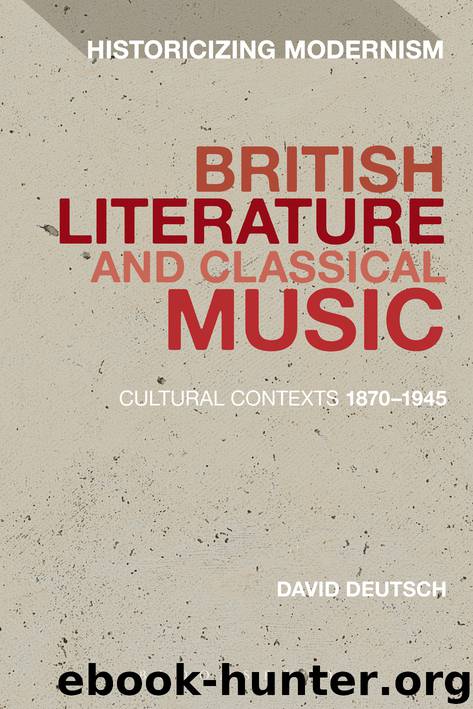British Literature and Classical Music by Deutsch David

Author:Deutsch, David
Language: eng
Format: epub
Tags: Cultural Contexts 1870–1945
Publisher: Bloomsbury UK
Published: 2015-03-14T04:00:00+00:00
An unexpected accord
This literary and historical outline brings us back to the modernist question examined in Chapter 2 regarding the social value of classical music, only now with a much wider context. This context includes not only the perspectives of middle-class literati, but also of lower-middle- and working-class musical amateurs and of the writers who sympathized with them. These perspectives suggest that these groups associated similar social values with classical music. Classical music could, then, be viewed as a seemingly arbitrary indicator of class divides. But as I have been arguing, the term also became imbued with the potential to redefine class identities, if only in a limited fashion. An appreciation of classical music, even, as Sidgwick suggests, as performed by brass bands, could signal intelligence and gentility while a lack of appreciation signaled intellectual laziness and vulgarity regardless of one’s inherited background or economic status.
As we have seen, middle-class literati used representations of classical music to assert their intellectual and cultural dominance and to create complex works of art. They depicted autobiographical characters as musically proficient, and hence as intelligent and genteel, while the majority of their upper- and middle-class musical characters resort to a half-hearted musicality in an attempt to retain a failing gentility. These latter characters re-enforce associations of classical music with a refined lifestyle and, through their lack of aesthetic acuity, reveal their cultural IQs to be scarcely higher than those of the allegedly unrefined lower-middle or working classes, represented by Frank Illidge in Huxley’s Point Counter Point or the caretaker’s children in Woolf’s The Years. Modernist authors, moreover, such as Eliot, Huxley, and Woolf emphasize the shallow musical appreciation of these characters in complexly structured “musical” novels to suggest the cultural bankruptcy of the majority of Britain’s upper and lower classes and to establish themselves as the primary executors of Britain’s cultural legacy.
The self-representations of a substantial number of lower-middle and working-class musical amateurs stand in distinct opposition to the representations of the unrefined lower classes imagined by most early-twentieth-century middle-class intellectuals and by most modernists, in particular. Benney, Bowyer, and Ring, among others, who themselves represent the countless audience members of Queen’s Hall concerts and East End concert societies, all describe their appreciation of music by Bach, Mozart, and Wagner, and lighter works by Donizetti or Verdi. They indicate, moreover, the joy, refinement, and sense of gentility this music brought to their lives. I have tried to illustrate how these amateurs fit into an oft-overlooked literary tradition. If largely ignored by canonical middle-class authors, underprivileged musical amateurs found representation in the intellectual, aesthetic, and sheer willful perseverance embodied within the brilliant “temperament” of Burke’s East End “factory girl,” Lawrence’s Aaron Sisson, Bennett’s Edwin Clayhanger, and more tangentially in Maugham’s and Mackenzie’s cockney ballet dancers and Lawrence’s nameless accumulation of collier piano-players, whom their authors refer to with respect, if at times begrudgingly so.
Ironically then, amidst all the glittering representations of musical events at Tantamount House and the Covent Garden Opera House, the modernist musical–literary
Download
This site does not store any files on its server. We only index and link to content provided by other sites. Please contact the content providers to delete copyright contents if any and email us, we'll remove relevant links or contents immediately.
Aircraft Design of WWII: A Sketchbook by Lockheed Aircraft Corporation(32140)
The Great Music City by Andrea Baker(30801)
Call Me by Your Name by André Aciman(19934)
The Art of Boudoir Photography: How to Create Stunning Photographs of Women by Christa Meola(18415)
The Secret History by Donna Tartt(18232)
Shoot Sexy by Ryan Armbrust(17565)
Plagued by Fire by Paul Hendrickson(17119)
Portrait Mastery in Black & White: Learn the Signature Style of a Legendary Photographer by Tim Kelly(16878)
Adobe Camera Raw For Digital Photographers Only by Rob Sheppard(16806)
Photographically Speaking: A Deeper Look at Creating Stronger Images (Eva Spring's Library) by David duChemin(16506)
Ready Player One by Cline Ernest(14034)
Pimp by Iceberg Slim(13808)
Bombshells: Glamour Girls of a Lifetime by Sullivan Steve(13705)
The Goal (Off-Campus #4) by Elle Kennedy(13212)
Art Nude Photography Explained: How to Photograph and Understand Great Art Nude Images by Simon Walden(12859)
Kathy Andrews Collection by Kathy Andrews(11344)
The Priory of the Orange Tree by Samantha Shannon(8641)
Thirteen Reasons Why by Jay Asher(8472)
The remains of the day by Kazuo Ishiguro(8419)
